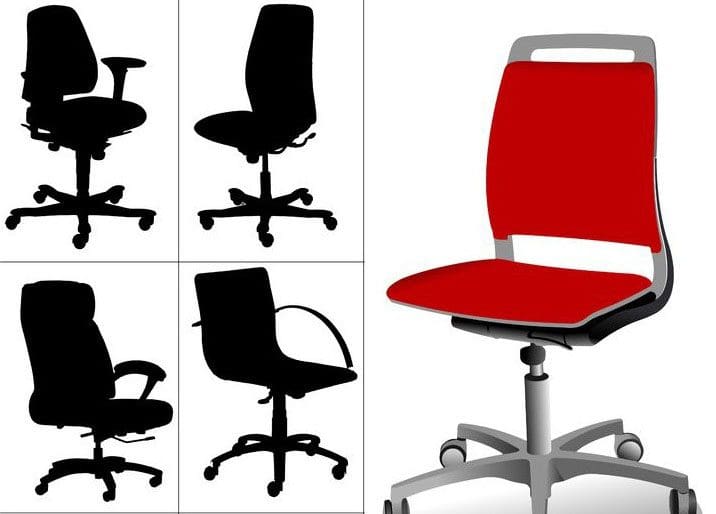Around 70% of America’s workforce sits in an office chair for most of the day. Then we spend extended time sitting down eating, studying, watching T.V., and driving. All of this time spent sitting is taking its toll on our bodies.

Effects of When We Sit Too Long
Sitting places added stress and pressure on the back because it transfers the body’s full weight onto the buttocks and thighs. Sitting for long periods can cause pressure to increase on the discs, which can lead to severe/chronic back pain. Sitting also takes a toll on the lower extremities. As the blood stays in the legs and feet this creates a sluggish return of blood to the heart.
In addition to sitting proper body mechanics are not implemented. Most of us sit with an improper posture, which can not only cause physical discomfort but also contributes to other health problems, which include:
- Abdominal pain
- Back pain
- Eyestrain
- Leg pain
- Neck pain
- Repetitive movement/motion injuries
Using a well-made ergonomic chair can help reduce fatigue, discomfort, increase blood flow, reduce injury, and increase job productivity.

An Ergonomic Chair
If it is to be used at a computer station or on a factory machine, it needs to be able to handle the tasks and fit the worker’s size. Here are some recommendations to help you pick a quality chair that will increase comfort and reduce injury.
Casters
Use a chair with casters either in the form of a pivoting roller/with wheels and a 5-point base to make movement easier. There are different types of casters, some for carpet use, and soft wheel casters for hard surfaces like tile and linoleum. Rubber locking casters can help prevent tipping. Also, choose a chair that swivels easily.
Seat Pan
The seat pan supports the majority of your weight. A chair with the cushion made from a dense, foam padding or spring coils is better than a basic cushion that loses its shape and compresses which causes discomfort, imbalance, and hip/back fatigue. The pan should be at least one inch wider than the hips and thighs on each side. The front part of the seat should slope down a little and allow a fist-sized space between the back of your knees and the front edge of the seat pan to reduce pressure on the back of the thighs.
Also, a chair with tilting adjustments allows the individual the ability to a forward working posture or a properly reclined posture. Some seat pans also have a sliding mechanism that can be beneficial. This means small and tall users are able to adjust the distance of the seat pan from the backrest.
The Backrest
Adequate back support is the most essential element of a backrest. Inadequate back support places added pressure on the spine. The backrest should be small enough to fit the small of the back, the pelvis, and back of the rib cage or be curved. Both provide adequate support. A lot of the chairs come with a built-in adjustment, that can be adjusted by turning a knob on one side or under the chair. Chairs with back supports that are large enough to provide mid-back and upper back support are an added bonus.

Armrests
Chairs with adjustable height and width are necessary with a chair with armrests. The armrest should be made of soft comfortable material and be 2 inches wide for adequate surface area.
Seat Height
Pretty much all chairs come with a seat height adjustment. A properly adjusted seat means that your feet can rest properly on the floor while the upper body is aligned with the computer, display, and keyboard. Hydraulic adjustments are standard on most chairs, but there are pneumatic adjustments that allow you to adjust the seat height while sitting on the chair. Keep in mind the mechanism to adjust the seat should be easy to reach.
Chair Reclining and Tilt Adjustment
The chair recline/tilt adjustment changes the angle of the entire seat. Like with the backrest angle adjustability, a reclined chair transfers upper body weight to the backrest of the chair. However, locking the backrest in one position is not recommended or beneficial for the back.

Considerations
Footrests
For most a footrest is not necessary. But if additional foot support is necessary, a floor-mounted rest will allow you to rest your feet in a comfortable position.
Fabric Types
Keep in mind the cleaning and maintenance that goes into the chair when choosing which. Upholstery is the most common covering but is not the easiest to keep clean. Vinyl and leather covers are easy to clean but don’t breathe well and can generate heat in the legs.
Safe Sitting
Other than using an ergonomic chair, here are some precautions to minimize discomfort and injury while sitting:
- Do not stay in one position for a long time.
- Change postures often.
- Shift between sitting and standing, 20 minutes of standing then 20 of sitting.
- Try to keep your feet flat on the floor.
- Sit with proper posture upright with your back and shoulders against the backrest.
- Do not use the armrests to slouch.
- Elbows and arms should rest lightly to promote circulation.
- Make sure the shoulders are relaxed and slightly dropped when on the keyboard.
Stay In a Neutral Posture
- With the back supported and straight
- The hips slightly higher than the knees
- Keep between 2-4 inches of the chair edge and behind the knees
- Maintain an equal balance of weight on the seat
Most Important
- Take frequent breaks
- Stand up and move around
- Stretch
- Be aware of your posture while your sitting
- Correct yourself if you are slouching or moving out of the proper posture
- Take deep breaths
This will increase blood flow and reduce fatigue. Small changes will go a long way and keep you comfortable and healthy.
Work smarter not harder
Because we spend so much time in a chair we need to have the right one that will protect our spines. Think of the chair as a piece of work equipment to optimize productivity. Ergonomics utilized to the fullest means less back pain and better focus.
When your body is truly healthy, you will arrive at your optimal health and proper physiological state. We want to help you live a new and improved lifestyle. Over the last two decades, while researching and testing we have learned what works effectively at decreasing pain while increasing human vitality.
Reduce your Back Pain with Foot Orthotics
NCBI Resources
Ergonomic chairs have come a long way, and they do help reduce spine problems, pain, and improve movement. Improving spinal health and hygiene at work is as simple as taking breaks for light stretching, walking around, and utilizing ergonomic office products to stay fit and injury-free. Whatever you choose, understand how your back and neck are moving/functioning during the workday/night by using ergonomic fundamentals that will keep your body/mind healthy and prevent office injuries.
Post Disclaimer *
Professional Scope of Practice *
The information herein on "Using an Ergonomic Chair and the Adjustments for a Healthy Back" is not intended to replace a one-on-one relationship with a qualified health care professional or licensed physician and is not medical advice. We encourage you to make healthcare decisions based on your research and partnership with a qualified healthcare professional.
Blog Information & Scope Discussions
Welcome to El Paso's Premier Wellness and Injury Care Clinic & wellness blog, where Dr. Alex Jimenez, DC, FNP-C, a board-certified Family Practice Nurse Practitioner (FNP-C) and Chiropractor (DC), presents insights on how our team is dedicated to holistic healing and personalized care. Our practice aligns with evidence-based treatment protocols inspired by integrative medicine principles, similar to those found on dralexjimenez.com, focusing on restoring health naturally for patients of all ages.
Our areas of chiropractic practice include Wellness & Nutrition, Chronic Pain, Personal Injury, Auto Accident Care, Work Injuries, Back Injury, Low Back Pain, Neck Pain, Migraine Headaches, Sports Injuries, Severe Sciatica, Scoliosis, Complex Herniated Discs, Fibromyalgia, Chronic Pain, Complex Injuries, Stress Management, Functional Medicine Treatments, and in-scope care protocols.
Our information scope is limited to chiropractic, musculoskeletal, physical medicine, wellness, contributing etiological viscerosomatic disturbances within clinical presentations, associated somato-visceral reflex clinical dynamics, subluxation complexes, sensitive health issues, and functional medicine articles, topics, and discussions.
We provide and present clinical collaboration with specialists from various disciplines. Each specialist is governed by their professional scope of practice and their jurisdiction of licensure. We use functional health & wellness protocols to treat and support care for the injuries or disorders of the musculoskeletal system.
Our videos, posts, topics, subjects, and insights cover clinical matters and issues that relate to and directly or indirectly support our clinical scope of practice.*
Our office has made a reasonable effort to provide supportive citations and has identified relevant research studies that support our posts. We provide copies of supporting research studies available to regulatory boards and the public upon request.
We understand that we cover matters that require an additional explanation of how they may assist in a particular care plan or treatment protocol; therefore, to discuss the subject matter above further, please feel free to ask Dr. Alex Jimenez, DC, APRN, FNP-BC, or contact us at 915-850-0900.
We are here to help you and your family.
Blessings
Dr. Alex Jimenez DC, MSACP, APRN, FNP-BC*, CCST, IFMCP, CFMP, ATN
email: coach@elpasofunctionalmedicine.com
Licensed as a Doctor of Chiropractic (DC) in Texas & New Mexico*
Texas DC License # TX5807
New Mexico DC License # NM-DC2182
Licensed as a Registered Nurse (RN*) in Texas & Multistate
Texas RN License # 1191402
ANCC FNP-BC: Board Certified Nurse Practitioner*
Compact Status: Multi-State License: Authorized to Practice in 40 States*
Graduate with Honors: ICHS: MSN-FNP (Family Nurse Practitioner Program)
Degree Granted. Master's in Family Practice MSN Diploma (Cum Laude)
Dr. Alex Jimenez, DC, APRN, FNP-BC*, CFMP, IFMCP, ATN, CCST
My Digital Business Card




